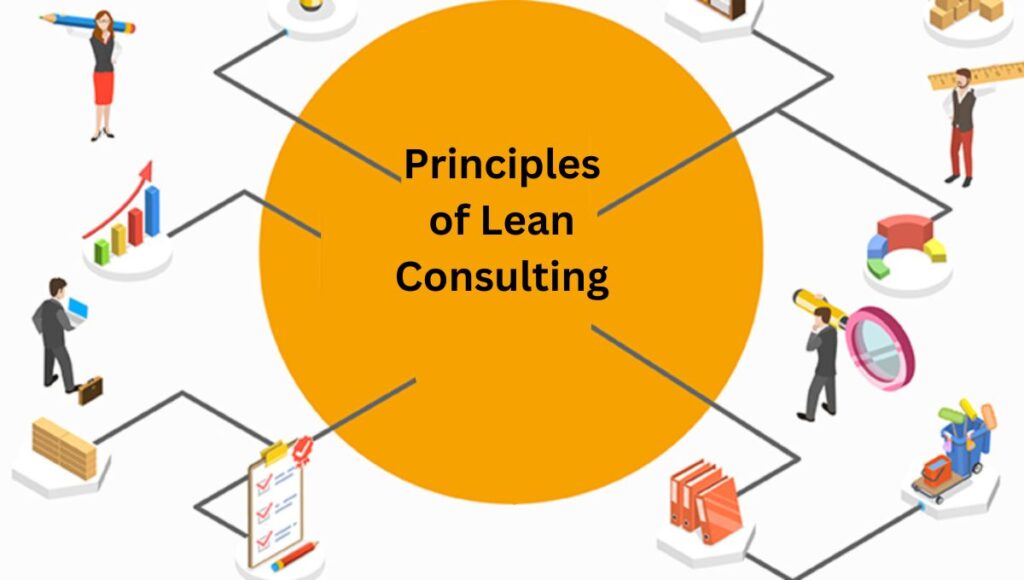Lean consulting is not just a method; it’s a philosophy focused on improving organizations in a sustainable manner. By concentrating on improving processes, reducing waste, and boosting productivity, it helps businesses achieve significant performance gains. This blog will delve into the core principles of lean consulting, showcasing how organizations can implement these principles and thrive in today’s fast-paced marketplace.
What is Lean Consulting?
Lean consulting stems from the lean manufacturing principles established by Toyota in the post-World War II era. It emphasizes creating more value for customers while consuming fewer resources. Although initially developed for the manufacturing industry, lean principles can be applied to various sectors, including healthcare, finance, and service industries.
Core Principles of Lean Consulting
To appreciate the depth of lean consulting, we need to examine the core principles that underpin lean methodologies. Here are the five main concepts:
- Value: Understanding what customers value is essential. Lean consulting seeks to identify customer needs and eliminate activities that don’t provide value. This means fully comprehending customer requirements and expectations before modifying processes.
- Value Stream: This principle identifies all the steps in a process, assessing each one to determine its contribution to value. It’s about mapping the current state of a process and finding ways to streamline it. By recognizing and analyzing these steps, businesses can eliminate waste and enhance efficiency.
- Flow: Once value is defined, it’s crucial to create a continuous flow in the process. Eliminating bottlenecks and ensuring smooth transitions between steps encourages rapid production and service delivery without interruptions.
- Pull: The pull principle flips traditional production methods on their head. Instead of producing goods based on forecasts, organizations should produce only what is needed when it is needed. This minimizes excess inventory and reduces waste, allowing businesses to respond swiftly to customer requests.
- Perfection: Lean consulting advocates for continuous improvement. There is always room for enhancement, whether in processes, products, or customer service. This principle encourages organizations to develop a culture of innovation where employees are engaged in identifying areas for improvement.
The Benefits of Implementing Lean Consulting
Adopting lean consulting principles can transform an organization. Here are some pivotal benefits:
1. Reduced Waste
By focusing on activities that add value and eliminating those that don’t, organizations can significantly reduce waste. This includes minimizing excessive inventory, overproduction, and coordinating efforts in a way that reduces redundancy.
2. Improved Quality
With a concentration on customer satisfaction, lean consulting supports higher quality products and services. By continuously improving processes, organizations can lower error rates and increase overall satisfaction among customers.
3. Enhanced Efficiency
Streamlining processes improves operational efficiency. Organizations can respond more quickly to market demands and make better use of resources.
4. Increased Employee Engagement
Involving employees in the improvement process fosters a culture of collaboration and innovation. Empowered employees feel valued, leading to higher motivation and productivity.
5. Better Customer Experience
By focusing on needs and values, organizations can enhance their customer offerings. A better customer experience often leads to repeat business, referrals, and a stronger market presence.
Steps to Implement Lean Consulting Principles
If you’re considering lean consulting for your organization, the following steps can help smooth the journey:
Step 1: Form a Lean Team
Building a dedicated lean team is essential for initiating change. This team should include individuals from various levels across all departments. Diverse perspectives encourage holistic improvements.
Step 2: Define Value
Identifying value from the customer’s viewpoint is the foundation of lean consulting. Gather data through surveys or interviews to understand what your customers really need.
Step 3: Map the Value Stream
Create a value stream map to visualize all steps in your processes. Identify areas of waste and inefficiencies. This exercise is critical in gaining insights into what to improve.
Step 4: Identify and Eliminate Waste
With the value stream map in place, start identifying non-value-adding activities. Focus on eliminating waste related to waiting, overprocessing, excess inventory, transportation, and defects.
Step 5: Improve Flow
Reorganize workflows to keep things moving smoothly from one step to the next. Analyze the rearrangement of resources or change working methods to create a better flow.
Step 6: Implement Pull Systems
Develop a system where production is driven by actual customer demand rather than forecasts. Technology, such as inventory management software, can assist in tracking real-time customer needs.
Step 7: Foster Continuous Improvement
Encourage ongoing improvements through regular training, meetings, and updates. Utilize techniques like Plan-Do-Check-Act (PDCA) cycles, Six Sigma methodologies, and Kaizen events to keep teams focused on enhancement.
Lean Consulting Tools and Techniques
There are several tools and techniques that lean consultants use to transform processes. Some of these include:
1. 5S System
The 5S methodology (Sort, Set in Order, Shine, Standardize, Sustain) is a powerful way to organize the workplace. It aims at maintaining cleanliness and order, thus enhancing efficiency.
2. Kaizen

Kaizen translates to “continuous improvement.” It involves all employees in the process of identifying small changes that can lead to better overall efficiency.
3. Six Sigma
Six Sigma focuses on quality control through data-driven approaches. It employs statistical methods to reduce defects and improve process outputs.
4. Value Stream Mapping
This technique captures the flow of materials and information as products move through a process. It highlights areas for improvement by illustrating waste clearly.
5. A3 Problem Solving
An A3 report is a structured problem-solving framework used to foster a systematic thinking approach. It encourages teams to identify problems, analyze root causes, and develop solutions.
Conclusion
In an era where efficiency can make or break an organization, lean consulting stands out as an effective strategy for improvement. By focusing on customer value, streamlining processes, and fostering a culture of continuous enhancement, businesses can achieve remarkable results.
Adopting lean principles not only improves operational performance but also creates a thriving environment where employees feel empowered and engaged. Take the leap into lean consulting; your organization could achieve extraordinary success and ensure long-term viability.
In closing, the journey towards lean consulting is never a straight path. It requires dedication, continuous effort, and commitment from every member of your organization. With the right focus and tools, you can harness the power of lean principles to transform your operations and enhance your offering in a competitive marketplace.
—
Feel free to utilize and adapt this blog in accordance with your audience’s needs. Embrace the change, and explore how lean consulting can work wonders for your business!
To understand the essential principles of Lean Consulting or for further information click on the given link: https://www.ribcon.com/
Stay tuned for more news and updates on Infinite Insight Hub!



